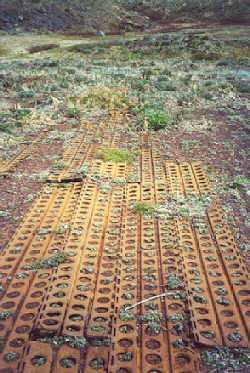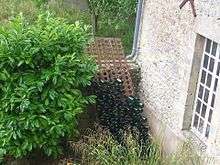Marston Mat

Marston Mat (also known as pierced (or perforated) steel planking (PSP)), is standardized, perforated steel matting material originally developed by the United States at the Waterways Experiment Station shortly before World War II, primarily for the rapid construction of temporary runways and landing strips. (The name is also misspelled as Marsden matting.) The nickname came from Marston, North Carolina adjacent to Camp Mackall airfield where the material was first used.[1]
Description

Pierced steel planking consisted of steel strips with punched lightening holes in it. These holes were in rows, and a formation of U-shaped channels between the holes. Hooks were formed along one long edge and slots along the other long edge so that adjacent mats could be connected. The short edges were cut straight with no holes or hooks. To achieve lengthwise interlocking, the mats were laid in a staggered pattern.
The hooks were usually held in the slots by a steel clip that filled the part of the slot that is empty when the adjacent sheets are properly engaged. The holes were bent up at their edges so that the beveled edge stiffened the area around the hole. In some mats a T-shaped stake could be driven at intervals through the holes to keep the assembly in place on the ground. Sometimes the sheets were welded together.
A typical later PSP was the M8 landing mat. A single piece weighed about 66 pounds and was 10 ft (3.0 m) long by 15 in (0.38 m) wide. The hole pattern for the sheet was three holes wide by 29 holes long resulting in 87 holes per mat.
The M9, made from aluminum was produced to allow easier transportation by aircraft, since it weighed about 2/3 as much. Aluminum plank was referred to as PAP for perforated aluminum planking,[2] but was and is not as common. Aluminum was a controlled strategic material during World War II, so much less was made, it was typlically only able to handle half as many loading cycles as steel, and its high scrap value and low weing lead to recycling rather than reuse.
After the war PSP was used by many southeastern U.S. auto racing teams since it was manufactured in the area, and used in many abandoned military airfields. It was also used during a similar period when NASCAR teams used car trailers.
History
World War II

Marston Mat was extensively used during World War II by Army engineers and Seabees (construction battalions) to build runways and other readily usable surfaces over all kinds of terrain. An early in-theatre use of PSP was in constructing a 5,000 foot runway on Greenland's 'Bluie West One' (BW-1), an Allied Ferry Command and U.S.A.A.F airfield located on the extreme southwest corner of Greenland, at the termination of Eriksfjord, and near the coastal community of Narsarsuaq. Construction began in early fall 1941, and the first airscraft landed on Jan 24, 1942. Deemed a success, it was then used extensively in the Pacific Theater of Operations. A C-47 Skytrain supply aircraft was the first plane to land on the first steel-mat runway constructed in France after the invasion of Normandy.[3]
On Pacific islands the matting was typically covered with crushed and rolled coral or soil to form a level surface. The perforated and channeled design of the matting created strength and rigidity and facilitated drainage. A runway two hundred feet wide and 5000 feet (1500 m) long could be created within two days by a small team of engineers.
Berlin Airlift
At the start of the Berlin Airlift the runways at Tempelhof Airport in the US Zone of Berlin were made of PSP. Designed to support fighters and smaller cargo aircraft, the Douglas C-54 Skymaster that formed the backbone of the U.S. effort was too heavy for the PSP. Berliners were hired to fix the runway between the three-minute arrivals, running onto the runways with bags of sand to dump onto the mats and soften the surface.
Legacy

Large quantities of matting were produced; approximately 2 million tons costing more than US$200 million (in the 1940s).[4] At the end of the war a large amount of the material remained as war surplus and was pressed into use in various civil engineering applications such as road and bridge construction. As they were made from steel with a high manganese content, the matting was also highly resistant to corrosion.[5] In various countries located in the Pacific Theatre, particularly in the Philippines and Papua New Guinea, matting still remains in use as fencing[6] or roadway barriers, in some cases stretching for miles.
Vietnam era
With the deployment of jet aircraft and helicopters, FOD (Foreign Object Damage) became a larger hazard. In moist tropical areas (such as Vietnam) vegetation growing through the mats also became an issue. Jet blast or rotor downdraft could stir up loose materials on the ground which might then be sucked into jet inlets, and vegetation required mowing or herbicides. The M8A1 mat was developed to prevent this, omitting the pierced holes that exposed the soil beneath.[7] This mat has a solid surface, strengthened by corrugations that also encouraged the drainage of rainwater. The mat size also changed to be 22 by 144 inches (560 mm × 3,660 mm).
Later mats were developed in a lightweight aluminum version, 24 by 144 inches (610 mm × 3,660 mm).[7] This was made as a hollow extrusion, rather than pressed. Aluminum matting allows greater quantities to be airlifted. Its greater scrap value encourages theft, so steel is preferred for larger or long-term installations.
See also
- Sommerfeld Tracking – a form of wire matting
- Corduroy road – a road-building method going back to prehistory.
- Sedes Airport – an airport in Greece using a PSP Metal Mesh Runway.
References
| Wikimedia Commons has media related to Marston Matting. |
- ↑ Mathis, S. J. (March 1943). "Mat "Seabees are Wizards at Building Battle-Front Air Bases". Aviation Week. 43: 181.
- ↑
- ↑ Gurney, Gene (Major, USAF) (1962). "The War in the Air: a pictorial history of World War II Air Forces in Combat". New York City: Bonanza Books: 175.
U.S. Air Force photo
- ↑ U.S. Army Corps of Engineers article on Landing Mat Development
- ↑ Manganese alloy properties
- ↑ Tarawa Photos
- 1 2 "Portable Runways Using Landing Mats". Calumet Industries.
External links
- These Portable Runways Helped Win the War in the Pacific – Air & Space Magazine
- A History of Landing Mats – Signature Aviation Matting
- Pierced Steel Planking: The Gates of the War – Storie del Sud